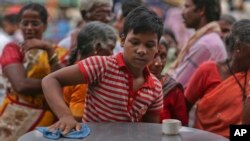Urban India is employing an increasing number of children — many under 9 years old — in producing everything from pickles to fireworks, working in tourism and laboring on building sites, a U.N. children's agency report and campaigners said.
The State of Child Workers in India report by UNICEF, based on the latest Indian census data, says the proportion of child workers in the 5-to-9-year age group jumped to 24.8 percent in 2011 from 14.6 percent in 2001.
The same decade also saw an increase in urban child laborers to 2.9 percent of the child population, up from 2.1 percent.
While across India there was a drop in child workers, to 3.9 percent in 2011 from 5 percent in 2001, campaigners say the problem could be much bigger, with data failing to capture the extent of child labor in the home.
Many children missed
Andrew Sesuraj of the nonprofit Tamil Nadu Child Rights Observatory said most of the information available takes into account only those children working in the organized sector.
"Girls doing domestic work, children in agriculture, those working with their parents are totally discounted. ... What we see is just the tip of the iceberg," Sesuraj said.
Helen R. Sekar, co-author of the report, which was published in February, said most child workers are migrants who have no home address and who do not figure on any government list.
"Investigators would not come across these children when they visit homes for data collection," Sekar said.
Other factors
Falling agricultural returns, landlessness and few work opportunities are also forcing rural families into cities, putting their children at greater risk, campaigners said.
The analysis shows that although education policies have led to a rise in literate children, inadequate family earnings still compel them to work and supplement household incomes.
Komal Ganotra of the nonprofit Child Rights and You said there was an increase in work being outsourced to Indian homes and wages being paid per piece produced.
"It is motivating parents to employ their children to earn more. The number of children working with their families and dropping out of school is increasing," Ganotra said.
The report cites the embroidery, shoe, carpet, garment, leather and lock-making industries as examples where "invisible children" work with their parents to increase household income.
32 locations cited
Produced in collaboration with the V.V. Giri National Institute of Labor, the report identifies 32 child labor hot spots, with the cities of Hyderabad and Jalore topping the list with 67,366 and 50,440 child workers, respectively.
The report says that while the growth of child workers is decreasing at 2 percent annually, at that rate it will take almost 200 years for India to eradicate child labor.
It calls for better implementation of education policies, including better schooling for migrant children, to reduce cases of child labor.
"We are looking at the report and will come up with suggestions accordingly," said Stuti Kacker, head of the National Commission for Protection of Child Rights.












